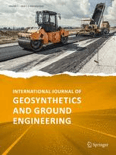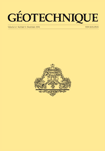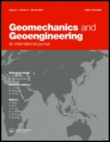
International Journal of Geosynthetics and Ground Engineering
Scope & Guideline
Transforming ground engineering through cutting-edge geosynthetic applications.
Introduction
Aims and Scopes
- Geosynthetic Reinforcement Techniques:
Focuses on the development and application of geosynthetic materials to reinforce soil and improve the mechanical properties of various substrates, including clay, sand, and composite materials. - Soil Stabilization Methods:
Explores innovative stabilization techniques utilizing geosynthetics, industrial by-products, and eco-friendly materials to enhance the performance of weak and expansive soils. - Numerical and Experimental Investigations:
Emphasizes a combination of numerical modeling and experimental studies to analyze the behavior of geosynthetic-reinforced structures and their interactions with surrounding soils. - Sustainable Geotechnical Practices:
Promotes sustainable engineering solutions by integrating recycled materials and eco-friendly practices in soil stabilization and ground improvement. - Advanced Characterization of Soil-Geosynthetic Interfaces:
Investigates the mechanical and hydraulic interactions between soils and geosynthetic materials, aiming to optimize their performance in various applications.
Trending and Emerging
- Utilization of Recycled and Waste Materials:
An increasing number of studies are exploring the use of recycled materials, such as plastics and industrial by-products, for soil stabilization and geosynthetic applications, promoting sustainability. - Climate Resilience and Adaptation:
Research focusing on the influence of climate change on geotechnical performance, including the long-term behavior of geosynthetics under changing environmental conditions, is gaining traction. - Advanced Computational Modeling Techniques:
There is a growing emphasis on using advanced computational methods, including machine learning and artificial intelligence, to predict soil behavior and optimize geosynthetic design. - Bio-inspired and Nature-based Solutions:
Emerging interest in bio-inspired techniques for soil improvement and ground stabilization reflects a trend towards incorporating natural processes and materials into engineering solutions. - Dynamic and Cyclic Loading Studies:
Research examining the behavior of geosynthetic-reinforced structures under dynamic and cyclic loading conditions is on the rise, addressing the need for improved resilience in infrastructure.
Declining or Waning
- Traditional Soil Improvement Techniques:
Research focusing on conventional soil improvement methods, such as lime and cement stabilization, has decreased as the field shifts toward more innovative and sustainable practices. - Generalized Soil Behavior Models:
Papers that present generalized or overly simplistic models of soil behavior without considering specific geosynthetic interactions are becoming less common, indicating a move towards more detailed and context-specific studies. - Static Load Testing without Advanced Analysis:
The frequency of studies solely relying on traditional static load testing methods has diminished, as there is a growing preference for integrating advanced analytical techniques and computational models.
Similar Journals

Transportation Infrastructure Geotechnology
Pioneering Research in Infrastructure Sustainability and Safety.Transportation Infrastructure Geotechnology, an esteemed journal published by SpringerNature, serves as a vital platform in the fields of Civil and Structural Engineering, Environmental Engineering, Geotechnical Engineering, and Transportation. Established in 2014 and spanning a decade of significant scientific discourse, this journal has gained recognition for its robust contribution to the understanding of the interplay between geotechnical processes and transportation infrastructure. With an impactful Q2 ranking in multiple categories—including Civil and Structural Engineering and Environmental Engineering—it emphasizes innovative research and practical applications globally. Researchers and professionals can explore critical topics that influence infrastructure sustainability, safety, and efficiency. Although it operates under a subscription model, its affiliation with SpringerNature ensures rigorous peer-review and high-quality publications, making it an indispensable resource for academics and industry experts alike.

Geotechnical Engineering
Transforming Ideas into Engineering SolutionsGeotechnical Engineering, published by the Southeast Asian Geotechnical Society, is a prominent journal dedicated to the field of geotechnical and civil engineering. With its ISSN of 0046-5828, this journal serves as a vital platform for researchers and practitioners to disseminate innovative findings and explore new methodologies within the discipline. Although currently listed in the Q4 quartile across both Civil and Structural Engineering and Geotechnical Engineering categories, Geotechnical Engineering is committed to fostering rigorous scholarship and community engagement in the dynamic field of geotechnical sciences. The journal covers a wide range of topics, providing an important resource for the engineering community. While it does not offer open access, it facilitates significant contributions that enhance the understanding and practice of geotechnical engineering in Southeast Asia and beyond, underscoring its vital role as a knowledge hub for researchers, professionals, and students alike.

International Journal of GEOMATE
Fostering dialogue among scholars and practitioners for a sustainable tomorrow.The International Journal of GEOMATE, published by GEOMATE INT SOC based in Japan, is a pivotal resource for scholars and practitioners in the fields of Building and Construction, Environmental Engineering, Geotechnical Engineering, and Soil Science. Established in 2011 and continuing to set the standard in its focus areas, this journal serves as a platform for innovative research and practical applications, with contributions that significantly enhance the understanding and development of sustainable engineering practices. With its current classification in the Q3 quartile across multiple categories, it strives to disseminate critical knowledge and foster dialogue among a diverse audience, including researchers, industry professionals, and students. Though operating under a traditional subscription model, the journal's emphasis on rigorous peer review and high-quality publications ensures a substantial impact factor, further reinforcing its reputation in academia. Spanning from 2011 to 2024, the International Journal of GEOMATE invites contributions that advance the knowledge frontier and address contemporary challenges in engineering and environmental science.

Geotechnique Letters
Fostering Excellence in Geotechnical Research.Geotechnique Letters is a prestigious journal published by Emerald Group Publishing Ltd, with a focused dedication to advancing the field of geotechnical engineering and engineering geology. Since its inception in 2011, the journal has rapidly established itself as a leading platform for disseminating high-quality research and innovative practices, earning a stellar Q1 ranking in both Earth and Planetary Sciences (miscellaneous) and Geotechnical Engineering categories as of 2023. With an ISSN of 2049-825X and E-ISSN 2045-2543, this journal captures vital insights and cutting-edge developments that cater to researchers, industry professionals, and students passionate about geotechnical challenges. Although it operates under a subscription model, the journal offers options for authors to publish their work—enhancing accessibility for those seeking to share knowledge within the community. The Scopus rankings place it comfortably within the top echelons of its field, affirming its importance and influence in shaping the future of geotechnical research and practice. With converged years extending to 2024, Geotechnique Letters is positioned as an essential resource for anyone looking to stay atop advancements and discussions in geotechnical sciences.

Civil Engineering Infrastructures Journal-CEIJ
Fostering innovative solutions for modern infrastructure challenges.Civil Engineering Infrastructures Journal (CEIJ), published by the University of Tehran, College of Engineering, is a premier platform dedicated to advancing the field of civil and structural engineering. With an ISSN of 2322-2093 and an E-ISSN of 2423-6691, CEIJ has been an Open Access journal since 2013, ensuring that critical research is accessible to a global audience. While it currently holds a Q4 category ranking in Civil and Structural Engineering as per the 2023 quartiles, the journal is committed to enhancing its reputation and impact within the academic community. Researchers, professionals, and students will find valuable insights in its compelling articles, which cover a wide array of topics pertinent to civil engineering infrastructures. The journal aims to foster innovative ideas and solutions that address contemporary challenges in the industry. As a publication rooted in Iran but reaching an international readership, CEIJ serves as a significant conduit for disseminating impactful research in the ever-evolving landscape of civil engineering.

GEOTECHNIQUE
Uncovering the Science Beneath Our FeetGEOTECHNIQUE is a prestigious peer-reviewed journal published by Emerald Group Publishing Ltd, specializing in the fields of Geotechnical Engineering and Earth and Planetary Sciences. Established in 1948, this journal has consistently delivered groundbreaking research and advancements in the science of soil and rock mechanics, engineering geology, and environmental applications, aiming to foster innovation in geotechnical practices. With an impressive impact factor reflected in its Q1 ranking within both the Earth and Planetary Sciences and Geotechnical Engineering categories, GEOTECHNIQUE is recognized as a leading source of scholarly articles, positioning itself among the top 5% in the field. The journal is accessible via subscription, providing a repository of invaluable insights for researchers, professionals, and students striving to push the boundaries of knowledge and application in geotechnical topics. With a robust editorial board and a commitment to excellence, GEOTECHNIQUE continues to contribute significantly to the academic community and the practical engineering landscape.

Geomechanics and Geoengineering-An International Journal
Pioneering Research in Geomechanics and GeoengineeringGeomechanics and Geoengineering-An International Journal, published by Taylor & Francis Ltd, serves as a prominent platform for the dissemination of innovative research and advancements in the fields of Geotechnical Engineering and Engineering Geology. With an ISSN of 1748-6025 and E-ISSN of 1748-6033, this journal has established itself as a critical resource within its category, ranking in the Q2 quartile according to the 2023 metrics and positioning itself in the top 38% of the Scopus rankings for Earth and Planetary Sciences. Geomechanics and Geoengineering encompasses a diverse range of topics, including but not limited to soil mechanics, foundation engineering, rock mechanics, and environmental geotechnics, ultimately aiming to advance both theoretical and practical knowledge in these vital areas. This journal not only highlights pioneering research but also facilitates a platform for academia and industry practitioners to collaborate and exchange ideas. While it does not offer open access, it remains a valuable resource for institutions and individuals committed to enhancing their expertise in the geotechnical domain. With convergence years spanning from 2006 to 2024, this journal is equipped to significantly contribute to the evolving landscape of geomechanical research.

International Journal of Geotechnical Engineering
Advancing Geotechnical Knowledge for a Sustainable FutureThe International Journal of Geotechnical Engineering, published by Taylor & Francis Ltd, is a leading academic platform dedicated to advancing knowledge and research in the field of geotechnical engineering, environmental engineering, and soil science. With an ISSN of 1938-6362 and an E-ISSN of 1939-7879, this journal has established a credible presence since its inception in 2007, reflecting its commitment to academic excellence through rigorous peer-reviewed research. Ranking in the Q2 quartile across several categories—including Environmental Engineering and Geotechnical Engineering—this journal boasts impressive Scopus rankings, placing it among the top publications in its disciplines. The journal seeks to foster a deeper understanding of soil behavior, geotechnical processes, and their environmental impacts, making it an essential resource for researchers, professionals, and students alike. While it operates under a subscription model, the wealth of knowledge and innovative findings disseminated within its pages are indispensable for anyone engaged in this vital field. With an expanding focus on interdisciplinary research and practical applications, the International Journal of Geotechnical Engineering continues to play a pivotal role in shaping the future of engineering practices worldwide.

International Journal of Engineering Research in Africa
Exploring the Future of Engineering in AfricaThe International Journal of Engineering Research in Africa is a pivotal academic resource for researchers, professionals, and students interested in the multifaceted field of engineering within the African context. Published by TRANS TECH PUBLICATIONS LTD, this journal facilitates the dissemination of innovative research, covering a myriad of topics in engineering, from advanced materials to sustainable practices. With an ISSN of 1663-3571 and E-ISSN 1663-4144, this publication not only fosters scholarly communication but also contributes to the global engineering discourse, as evidenced by its current Q3 ranking in the Engineering (miscellaneous) category in 2023. Operating from its base in Switzerland, the journal has been actively publishing since 2010 and continues to play a vital role in the advancement of engineering knowledge, particularly in the African landscape. Although it does not offer an open access model, the journal's commitment to quality research ensures that it remains a valuable asset for those seeking to understand and innovate within the engineering sector. Its integration in Scopus with a rank of #175 out of 307 in General Engineering further underscores its relevance and impact in the engineering community.

Rock and Soil Mechanics
Advancing Knowledge in Rock and Soil MechanicsRock and Soil Mechanics is a premier academic journal published by SCIENCE PRESS focusing on the critical fields of civil and structural engineering, geotechnical engineering, and soil science. With an ISSN of 1000-7598 and transitioning to an Open Access format since 2020, the journal strives to enhance the accessibility of cutting-edge research to a global audience, making significant contributions to practices and methodologies in these crucial disciplines. Ranked in the Q2 category for Civil and Structural Engineering as well as Geotechnical Engineering and Engineering Geology, and Soil Science, it boasts respectable standings in Scopus rankings, further affirming its relevance and credibility within the scientific community. The journal not only serves as a platform for original research but also engages with the latest advances in technology and innovative applications in rock and soil mechanics, proving invaluable for researchers, practitioners, and students alike as they navigate an increasingly complex field of study.